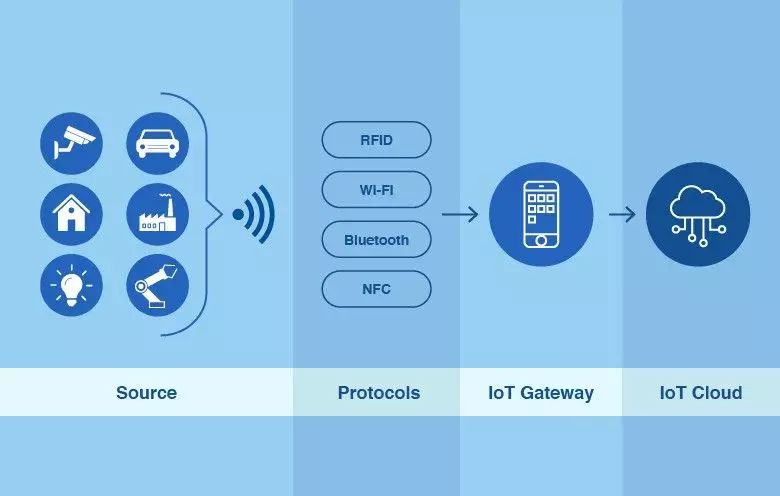How does mobile devices can act as an IoT Gateway? A major evolution in IoT architecture
Reading time
Level

The Internet of Things (IoT) has revolutionized the way we interact with the world around us. IoT-based communication holds relevance across various industry verticals, including: Construction and Smart Building, Transport & Telematics, Industry 4.0, and Healthcare, among others.
The adoption of IoT technology has witnessed substantial growth across these diverse sectors and continues to expand. One of the most interesting developments in this field is the use of mobile devices as IoT gateways. In this article, we’ll explore how this approach is redefining IoT architecture, the benefits and use cases it offers.
What is an IoT gateway ?
An IoT gateway is a device or software component that serves as a bridge between IoT devices and the cloud or central data processing systems. It enables communication, data collection, and often performs data preprocessing tasks, making it easier to manage and analyze data from a diverse set of IoT devices.
IoT gateways play a critical role in ensuring data transmission, security, and interoperability within IoT networks. For more information, we invite you to read our in-depth blog article on BLE Gateway
How does mobile acts as an IoT Gateway ?
Mobile devices, such as smartphones and tablets, can act as IoT gateways by serving as central communication hubs, connecting to a wide range of IoT devices using various protocols. They can collect data from their environment or attached sensors, process this data locally using their built-in sensors and processing capabilities, and then transmit it to the cloud or other IoT devices. Additionally, mobile devices provide a user-friendly interface through dedicated apps, allowing users to conveniently monitor and control IoT devices, making them an integral part of the IoT ecosystem.
In today’s context, smartphones assume a central and pivotal role within the ecosystem of IoT-based communications. These omnipresent and easily accessible devices, used by millions globally, serve as a cornerstone in this regard. It’s worth noting that smartphones are not just communication devices; they are equipped with an array of built-in sensors, including GPS, cameras, accelerometers, gyroscopes, and proximity sensors, complemented by diverse wireless communication technologies like Wi-Fi, Bluetooth, RFID, and NFC.
Smartphones are set to play an important role as gateways in the IoT ecosystem. Leveraging smartphones in this capacity offers a unique opportunity to improve the cost-effectiveness and accessibility of IoT technology, making it more widely available.
Mobile as a gateway architecture : How does it work ?

The illustration above illustrates that the mobile device plays a central role, surrounded by IoT devices operating as peripherals. These IoT devices fulfill their role by transmitting data packets and signaling their presence to the central nodes. When a mobile gateway receives data, it establishes an internet connection to facilitate data transfer.
To ensure streamlined data flow from IoT devices, key parameters such as data type, use case, location and data transmission rate need to be precisely defined. Once the data has been received, the gateway assembles it into a coherent data set, then sends to the designated destination.
What are the benefits of mobile as an IoT Gateway ?
Open protocol and connectivity
Smartphones have become powerful gateways in the rapidly evolving Internet of Things (IoT) landscape, thanks to their adherence to open communication protocols. Notably, Bluetooth, one of the most versatile wireless standards, is a key player in this ecosystem. Smartphones seamlessly integrate with Bluetooth-enabled IoT devices, thanks to this open protocol.
The openness of Bluetooth ensures that smartphones can communicate with a wide range of devices without the need for proprietary connectors or complex configurations. This ease of connectivity is a game-changer, simplifying the user experience and promoting the widespread adoption of IoT technology. It’s this commitment to open protocols that makes smartphones indispensable as IoT gateways, facilitating smoother integration and enhanced accessibility across diverse IoT applications.

Discover our range of sensors and beacons
compatible with IoT gateways
Increased accessibility
The use of mobile devices as IoT gateways marks an important step in the evolution of IoT architecture. However, it is essential to implement robust security measures to protect sensitive data. With this new approach, the Internet of Things is set to become even more accessible and ever-present in our everyday lives, paving the way for a more connected and intelligent future.
Reduction of costs
Rather than deploying dedicated IoT devices, using existing mobile devices can significantly reduce infrastructure costs. Using mobile as an IoT gateway enables companies to save on the purchase of specialized hardware.
Modern smartphones are equipped with powerful processing capabilities. This means they can perform IoT data pre-processing operations locally.
Ease of configuration and use
The simplicity of configuration and use is a significant advantage of employing smartphones in IoT setups. Given the widespread usage of smartphones among consumers, the process of configuring and managing IoT devices becomes more user-friendly and accessible.
In scenarios where an industrial gateway encounters issues, whether internally or externally, causing disruptions in data transmission, an open gateway IoT architecture can step in. This architecture enables devices to utilize any available smartphone to relay and receive data, ensuring continued connectivity and data flow.
Multi-protocol integration
Mobile devices are equipped with multiple communication protocols, such as cellular, Wi-Fi, Bluetooth and NFC connectivity. This means they can act as bridges between different IoT devices and technologies, facilitating integration.
Enhanced security
Security is a major concern in the IoT. Smartphones often benefit from regular updates and security protections, which can enhance the security of the overall IoT infrastructure. Therefore, when smartphones are an integral part of an IoT ecosystem, they not only contribute to their own security, but also play an essential role in protecting the wider network of interconnected devices.
Scalability and diversity of applications
With the growing number of mobile devices in the world, IoT infrastructure based on these devices can easily adapt and evolve to meet a multitude of applications, from home automation to industry. Smartphone gateways can enhance IoT use cases such as smart cities, smart agriculture, smart healthcare, smart logistics and smart manufacturing.
Limits to using mobile devices as IoT gateways
In many cases, mobile IoT gateways can be useful because they offer better accessibility, but it’s important to note that using a smartphone as an IoT gateway has certain limitations. For example, battery life can be an issue, as smartphones are generally not designed to operate continuously as gateways. In addition, Internet connection stability can vary depending on network coverage and Wi-Fi availability.
Conclusion
In the IoT world, mobile devices have emerged as versatile gateways, connecting easily through open protocols such as Bluetooth. They offer cost-effectiveness, user-friendly configuration, local data processing and enhanced security.
While smartphones offer incredible advantages, it’s important to note their limitations, particularly in terms of battery life and connectivity stability as smartphones are generally not designed to operate permanently as gateways. In addition, Internet connection stability can vary depending on network coverage and Wi-Fi stability. Nevertheless, their accessibility and adaptability make them essential tools for companies seeking to digitize their internal and external processes.



